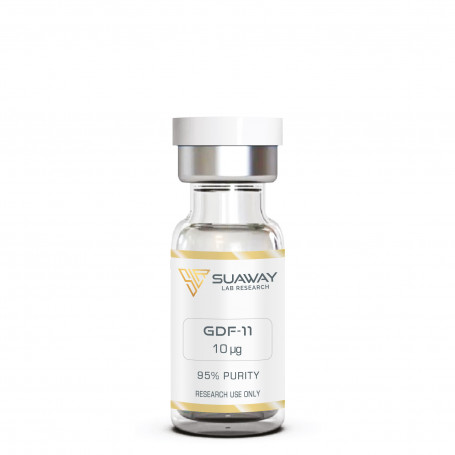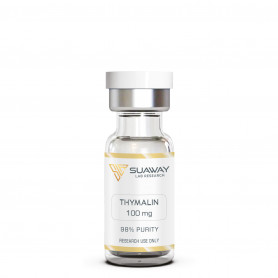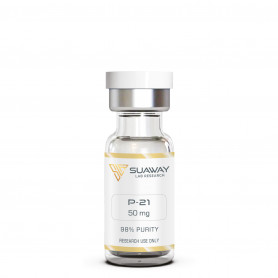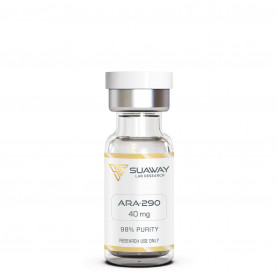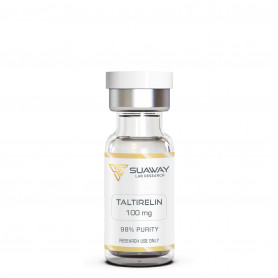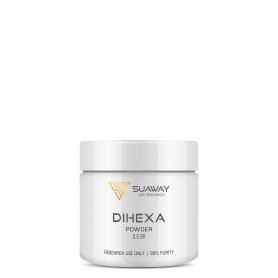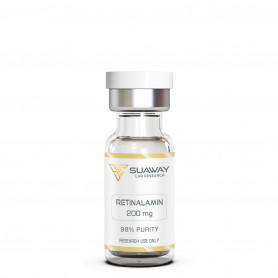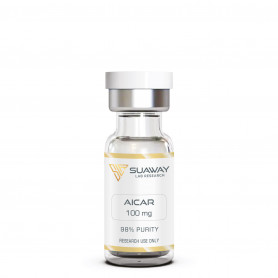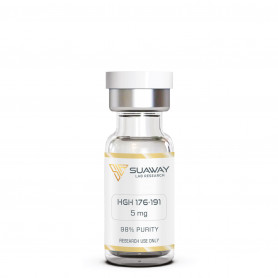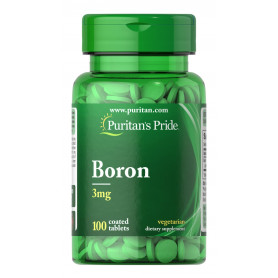GDF-11 - 10 ug
GDF11 has been shown to improve the outcomes of neurodegenerative and neurovascular diseases, increase the amount of skeletal muscle and boost muscular strength. It also has the power to reverse age-related degenerative alterations, as well as govern organ and skin regeneration following damage. These are all examples of its biological effects, which include reversing senescence.
Beschreibung
STRUCTURE
Sequence: NLGLDCDEHS SESRCCRYPL TVDFEAFGWD WIIAPKRYKA NYCSGQCEYM FMQKYPHTHL VQQANPRGSA GPCCTPTKMS PINMLYFNDK QQIIYGKIPG MVVDRCGCS
Molecular Weight: 11.9 kDa
Protein purity: greater than 95%
Other details: No TFA Salt
Storage: Lyophilized peptide must be stored at -20°C and peptide solution at 4°C.
GDF-11 has low oral and excellent subcutaneous bioavailability.
DESCRITPION
Growth differentiation factor 11 (GDF11) also known as bone morphogenetic protein 11 (BMP-11) is a protein that in humans is encoded by the growth differentiation factor 11 gene.
Skeletal muscle, pancreatic tissue, kidney tissue, nervous system tissue, and retinal tissue are some of the tissues that express GDF11.
A crucial element in the regeneration of aged cells is a protein known as growth differentiation factor 11 (GDF11). GDF11 has been shown to improve the outcomes of neurodegenerative and neurovascular diseases, as well as increase the amount of skeletal muscle and boost muscular strength. In therapeutic applications, it may be possible for it to reverse senescence. Additionally, it may be able to reverse age-related degenerative alterations and regulate organ regeneration after damage. These are only some of the wide-ranging biological impacts that it may have.
Ischemic cardiac injury is the primary factor that leads to heart failure, and the regenerative potential of intrinsic stem cells plays a vital part in the restoration of injured tissue after it has been damaged. On the other hand, stem cells found in older people have a lower capability for regeneration, and older tissues cannot renew themselves. It has been shown that the growth differentiation factor 11 (GDF11), which is a member of the activin-transforming growth factor β superfamily, encourages the activity and renewal of stem cells.
To examine the expression of GDF11 mRNA in the myocardium at baseline, as well as after ischemia/reperfusion (I/R) and myocardial infarction, young mice (three months) and elderly mice (twenty-one months) were employed in the study. The expression of GDF11 reduced with age and after the damage had been done to the myocardium. GDF11 expression was efficiently and selectively elevated in the elderly heart after I/R damage thanks to UTMD-mediated delivery of the GDF11 plasmid. This resulted in better cardiac function and smaller infarct size. In older mouse hearts, overexpression of GDF11 led to a reduction in the amount of p16 cells, which also led to a drop in the senescence markers p16 and p53. In addition, following GDF11 over-expression, there was an increase in the proliferation of cardiac stem cell antigen 1 (Sca-1+) cells, as well as an increase in the homing of endothelial progenitor cells and angiogenesis in older hearts that had been damaged by ischemia. Repetitive targeted delivery of the GDF11 gene by UTMD is capable of rejuvenating the old mouse heart and protecting it against I/R harm.
The aging process brings both cellular and functional deficits in the brain, both of which increase the organ's susceptibility to neurodegenerative diseases. Researchers have found several distinct components in the blood plasma of young and elderly animals. One of these factors is called growth differentiation factor 11 (GDF11), and its levels are higher in young animals. It would seem that the blood concentrations of these substances have an inverse correlation with the natural decrease in neurogenesis that occurs with advancing age. The discovery that GDF11 acts as a "rejuvenating factor" paves the way for new possibilities in the treatment of disorders that affect the nervous system. As an agent that is both pro-neurogenic and pro-angiogenic, GDF11 has the potential to serve as the foundation for innovative treatment approaches.
It has been proven that GDF11 can influence the differentiation and/or proliferation of progenitor cells in tissues.
It is well knowledge that keratinocytes change as they migrate through the many layers of the epidermis on their way to the surface of the body. During the process of keratinocyte differentiation, the exact regulation of the process is stringently regulated by many signaling pathways, which are controlled by Ca2+, cell-cell contact, and TGFβ. During this process, the differentiation of keratinocytes occurs. It is via the expression of other variables, such as p27Kip1 and IL-23, that the involvement of GDF11 becomes apparent.
It has been shown that the capacity of GDF11 to upregulate p27Kip1 is connected with the impact that it has on progenitor cells. P27Kip1 is a critical component in the regulation of keratinocytes' ability to halt their proliferation and differentiate into mature forms. P27Kip1 protein expression level was shown to be decreased in both the cytoplasmic and nuclear compartments of a human psoriatic keratinocyte cell line, which suggests a translocation from the nucleus and subsequent degradation of this protein. This was shown by the fact that the P27Kip1 protein expression level was decreased. P27Kip1 has been shown to have a key role in the pathogenesis of psoriasis, which is characterized by uncontrolled keratinocyte proliferation. Psoriatic epidermal hyperplasia, which is caused by abnormal keratinocyte differentiation and resistance to apoptosis, may be caused by the downregulation of p27Kip1, which can promote apoptosis. The inflammation of the skin provides evidence that GDF11 and IL-23 expression in keratinocytes are related to one another. An IL-23-induced skin inflammation model that was established to investigate the anti-inflammatory effect of GDF11 found that, on the skin, the infiltration of inflammatory cells and epidermal thickening were limited by recombinant GDF11. Recent research suggests that GDF11 might be an interesting therapeutic target for the prevention and treatment of skin that has psoriasis-like symptoms.
Human dermal skin fibroblasts are critical for the healing of wounds because they release type I collagen and cytokines. It has been observed in the past that fibroblast implantation plays an essential part in the process of skin regeneration and the healing of wounds. Within this framework, research into the function of GDF11 in dermal fibroblasts of the skin has been conducted. When compared with neonatal fibroblasts, the GDF11 expression and activity levels of fibroblasts derived from adult donors were shown to be lower. The primary impact of GDF11, which was seen in both adult and neonatal fibroblasts, was the production of collagen I and III.
Recent research suggests that mesenchymal stem cells (MSCs) release cytokines and growth factors that are involved in the process of regeneration and wound healing. This might explain the relationship between MSCs and skin regeneration. GDF11 is secreted by MSCs produced from primitive umbilical cord blood. Research has shown that GDF11 causes fibroblasts to produce more extracellular matrix proteins, such as collagen types I and III and fibronectin.
Tumor necrosis factor-α (TNF-α), plays a key role in inflammatory diseases, including skin inflammation, while GDF11 works to suppress inflammatory responses. GDF11 treatment antagonizes TNF-α-induced inflammation in macrophages, and the administration of GDF11 seems to reduce the inflammation that is present in the skin.
Studies show that TNF-α–induced activation of the nuclear factor kappa B (NF-κB) signaling pathway, which is known to participate in various inflammatory conditions, is limited by GDF11 treatment.
In yet another recent study, researchers investigated the impact of rGDF11 on several skin cells, including human epidermal-dermal fibroblasts, keratinocytes, melanocytes, and dermal microvascular endothelial cells. The researchers found that the generation of hyaluronic acid and procollagen underwent significant alterations when the skin models were treated with physiologically relevant doses of rGDF11. According to the findings of this research, rGDF11 is capable of generating Smad2/3 phosphorylation in those cells; as a result, it may have favorable effects on the vasculature of the skin, which is altered by aging.
REFERENCES
C. Zhang et al., "Growth differentiation factor 11 promotes differentiation of MSCs into endothelial-like cells for angiogenesis" [PubMed]
Guo-Qing Du et al., "Targeted myocardial delivery of GDF11 gene rejuvenates the aged mouse heart and enhances myocardial regeneration after ischemia-reperfusion injury" [PubMed]
Y. Ma et al., "Growth differentiation factor 11: a "rejuvenation factor" involved in regulation of age-related diseases?" [PubMed]
Y. Zhao et al., "GDF11 enhances therapeutic efficacy of mesenchymal stem cells for myocardial infarction via YME1L-mediated OPA1 processing" [PubMed]
L. Rochette et al., "Neuroprotective Potential of GDF11: Myth or Reality?" [PubMed]
L. Zhao et al., "TERT assists GDF11 to rejuvenate senescent VEGFR2+/CD133+ cells in elderly patients with myocardial infarction" [PubMed]
C. Zhang et al., "GDF11 enhances therapeutic functions of mesenchymal stem cells for angiogenesis" [PubMed]
DISCLAIMER
This product is intendend for lab research and development use only. These studies are performed outside of the body. This product is not medicines or drugs and has not been approved by the FDA or EMA to prevent, treat or cure any medical condition, ailment or disease. Bodily introduction of any kind into humans or animals is strictly forbidden by law. This product should only be handled by licensed, qualified professionals.
All product information provided on this website is for informational and educational purposes only.

